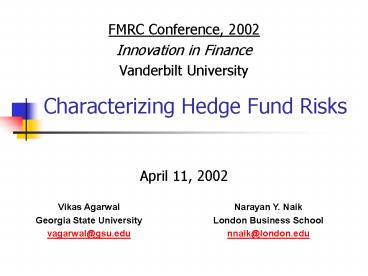Characterizing Hedge Fund Risks PowerPoint PPT Presentation
1 / 22
Title: Characterizing Hedge Fund Risks
1
Characterizing Hedge Fund Risks
FMRC Conference, 2002 Innovation in
Finance Vanderbilt University
- April 11, 2002
Vikas Agarwal Georgia State University vagarwal_at_gs
u.edu
Narayan Y. Naik London Business
School nnaik_at_london.edu
2
Background
- Rapid growth in the hedge fund industry
- Significant investment by institutional investors
including Endowments, Pension funds, Foundations
and Charities etc.
3
Risk-Return Characteristics
- Low correlation with standard asset classes
- Dynamic nature of trading strategies and
option-like payoffs - There are many factor risk premia
- Mutual funds (or buy-and-hold type strategies)
provide exposure to market, credit and liquidity
risk premia. - Dynamic trading or Option-based trading
strategies can provide exposure to volatility
risk premia (compensation for stochastic
volatility risk, price-jump risk etc. see Jun
Pan (JFE 2001))
4
Evidence on non-linearities
- Trend-following strategies employed by CTAs
exhibit lookback straddle-like payoff (Fung and
Hsieh (RFS 2001)) - Event or Risk Arbitrage strategies exhibit
payoff similar to writing an uncovered put option
on the market index (Mitchell and Pulvino (JF
2001))
5
An Example of Non-Linearities Case of Event
Driven Strategy
Event Driven Index Exposure to Russell 3000 Index
6
4
2
0
-15
-10
-5
0
5
10
Event Driven Index Returns
-2
-4
-6
-8
Russell 3000 Index Returns
6
Behavior of Residuals without Options
7
Behavior of Residuals with Options
8
Our Generic Approach
- Augment the traditional linear factor model with
option-based strategies - Option-based factors proxy for
- Dynamic trading strategies
- State-contingent bets
9
Research Questions
- What are the systematic risk components of hedge
fund returns? Do other hedge fund strategies
show non-linear risk-return tradeoffs as well? - Can we passively replicate hedge fund payoffs
buy-and- hold and option-based strategies? - What implications do non-linearities have in
portfolio decisions?
10
Our Study -main findings
- A wide range of hedge fund strategies
especially the non-directional ones - show
non-linear risk-return payoffs - Findings for Event Arbitrage are similar to that
of Mitchell and Pulvino (JF 2001) results
independent corroboration - Replicating portfolios explain out-of-sample
variation - Findings are robust to Choice of database,
Options on broader index and alternative
non-linear specifications
11
Sample Data
- Hedge Fund Research (HFR) Database
- Index Performance Jan 90 to Jun 00
- Individual Fund Performance Jan 90 to Aug 99
- CSFB/Tremont (CSFB) Database
- Index and Individual Fund Performance Jan 94
to Jun 00
12
Equity-Oriented Hedge Funds
- Event Driven
- Relative Value Arbitrage
- Equity Hedge (Long-Short Equity)
- Equity Non-Hedge
- Short Selling (Dedicated Short-Bias)
13
Classification
- Non-directional Strategies
- Event Driven
- Relative Value Arbitrage
- Equity Hedge (Long-Short Equity)
- Directional Strategies
- Equity Non-Hedge
- Short Selling (Dedicated Short-Bias)
14
Multifactor Model
- HFt Hedge Fund Return at time t
- BHt Buy-and-Hold Strategy Return at time t
- OSt Option-Based Strategy Return at time t
15
Buy-and-Hold Strategies
- Market Risk Factors
- Equities U.S. and Non-U.S.
- Fama-French Size and Book-to-Market Factors
- Carharts Momentum Factor
- Bonds Government and Corporate
- Currencies
- Commodities
- Default Risk
- Change in Default Spread
- High Yield Bond
16
Option-Based Strategies
- CME-traded SP 500 Composite index options
(European) - At-the-money options
- S / PV(X) 1.0
- Out-of-the-money options
- S / PV(X) 1.0 0.01
17
Results
Sample Period Jan 90 to Dec 99
18
Robustness Checks
- Choice of database
- Sub-period Analysis
- Use of lagged Russell 3000 index
- Options on a broader equity index (Russell 2000)
- Use of deeper out-of-the-money options
- Use of American-style options on SP 500 futures
- Alternative non-linear specifications
19
Implications of non-linearities
- Underestimation of expected loss using M-V
analysis - Fung and Hsieh (1999)
- Mean-Variance Analysis Limited applicability
- Alternative framework for portfolio optimization
and asset allocation - Mean-Value-at-Risk approach
- Conditional Value-at-Risk
- Conditional Drawdown Risk
- Smoothed Value-at-Risk
20
Concluding Remarks
- Option-based strategies capture non-linear risks
- Number of hedge fund strategies writing deep
out-of-the-money options (similar to selling
portfolio insurance or catastrophic insurance)
21
Concluding Remarks (contd.)
- Potentially useful in
- Asset allocation
- Construction of fund of hedge funds
- Risk management
- Design of benchmark and managerial compensation
contract
22
Research Paper URLs
- http//papers.ssrn.com/paper.taf?Abstract_id15308
8 - http//papers.ssrn.com/paper.taf?Abstract_id19038
9 - http//papers.ssrn.com/paper.taf?Abstract_id23870
8 - Or
- http//www.hedgeworld.com/research/reports/top_dl.
cgi - Most requested research reports number 2, 7 and
8. - Or
- http//www.gsu.edu/fncvaa/research.htm
- Or
- http//www.london.edu/faculty_research/working_pap
ers/working_papers.html (Search under author
Naik NY) - IFA working paper numbers 289, 298, 300 and 305

